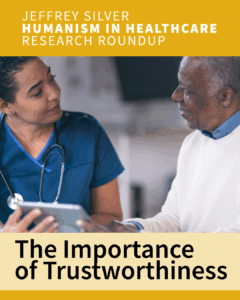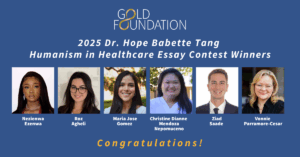Dr. Mike Natter is a Gold Humanism Honor Society member and resident physician at NYU Langone, a New York City hospital and Gold Partners Council member hospital that has been on the front lines of the heaviest hit U.S. city in the COVID-19 pandemic. A lifelong artist, Dr. Natter has recently begun sharing illustrations of his colleagues on Instagram, their faces obscured by face shields and masks, yet still brimming with powerful humanity. You can follow Dr. Natter on Instagram (@mike.natter) and Twitter (@mike_natter) and on his website, where he sells prints of his art. A portion of each sale goes toward the Juvenile Diabetes Research Foundation. The Gold Foundation recently interviewed Dr. Natter by email to learn more about his current series of illustrations and his thoughts about humanism and the human connection in the age of COVID-19.

“It’s shocking how the surreal nature of the Covid pandemic has become ordinary. Wearing masks, entering isolation rooms and swabbing patients for Covid is a part of the daily ritual of emergency rooms. It feels like all of my patients have Covid. I think a lot about what’s going to happen after we get through this crisis. I hope we can avoid making the same mistakes again. Thousands of deaths could have been prevented if we were more prepared.” -Bon Ku, MD. Illustrated by Mike Natter, MD
Thank you for all you and your colleague are doing on the front lines of this crisis, caring for critically ill patients in an environment that puts yourselves at risk. Your latest project on Instagram shows the humanity of your colleagues, behind face masks and shields, with their eyes deep with emotion. It’s so moving. How did this project first begin? What kind of feedback have you received?
As a doctor, we are very much on the front lines, but so are many of our other colleagues — especially the nurses that we work with. Often, it is our nursing peers who are needing to repeatedly go in and out of patient rooms, constantly exposing themselves to COVID-19. A nursing friend of mine posted a captivating and moving selfie in her PPE on her social media. Her eyes spoke to me. There was a sense of courage, pride, and fear that was staring back at me behind her face shield. Despite the rest of her face being hidden behind her N95 mask, her face carried all of the emotion and expression that we are all carrying during this difficult time. It compelled me to draw it. After completing the portrait, I thought about telling her story and using my platform to celebrate her courage but also express the hardships. That’s how my portraits of healthcare worker series began. I was very surprised at the response — it seems that it struck a chord with the healthcare community and beyond. I am just glad I am able to use my platform to raise others up and project awareness, hope, and positivity.
You have such an interesting background, as an artist who became a physician. How has art helped in your path as a physician and in your care of patients?
Medicine is much more of an art than a science. My background in art helped me in a many ways as a doctor, although it was not apparent at first. Being an “art kid,” I shied away from the hard sciences while I was growing up and in college. It was not until I realized that my artistic tendencies could help me learn medicine that I recognized I had a secret weapon. I utilized doodles and illustrations in med school for didactic purpose, translating difficult-to-understand medical concepts into my own visual language.
From there, my art became a catharsis, a way of helping me cope with difficult clinical rotations, losing patients, and the archaic and sometimes difficult journey that is medical training. Once in residency, my art has taken on more roles — still as catharsis for my self expression and decompression, but also to help communicate to my patients, teach my interns and medical students. Art teaches one how to observe, and those skills are ever-present for a physician. Art also is inherent to humanism and it is that artistic drive that I believe allows me to connect more fully to my patients.

“Everyday in the Emergency room feels different these days. There have been frequent changes to workflow, PPE and visitor policies. Change has been constant but necessary. Now more than ever our patients and their families need us. Now more than ever we need each other. To the man in the stretcher behind the mask from the nurse in the scrubs behind the mask, it’s okay to be scared, but please know this: These times might be uncertain but one thing is for absolute certain, you are not alone. We are here for you and we will not stop fighting for you.” -Danielle G, RN. Illustrated by Mike Natter, MD
Has this pandemic affected your art? Your care of patients?
Yes and no — my art has always been a source of catharsis that reflects my every day in the hospital, so in that way my art is still serving that purpose, but as with everyone else in the world right now, our lives have drastically changed. This alteration has been reflected in both my art and our care of patients. My art now seems to have themes of COVID, both overt and subtle. How we treat our patients has had to be altered as well. We are trained as physicians to spend as much time as you can at the bedside. Palpate the belly. Assess for edema. Feel for crepitus. Listen for crackles. Learn about who they are. These times have changed that. We need to limit how often we go in the patient room, for our safety and all of our patients. Most of our patients are on ventilators and sedated, which makes it impossible to communicate with them. The task has now been shifted to find a way to maintain our humanity as doctors and for our patients. Now instead of talking to family members at the bedside, we Facetime them in the room. Those have become my most meaningful and difficult moments.
How do you make space for art with the pace of this emergency?
As with anything else in life, you make time for the important things and the things that keep you grounded.
In this time of COVID-19, when it is so difficult to connect, art seems like both a solace and an important avenue for connection. How are you connecting with patients, and with friends and family, when these are so many additional barriers in physical distancing?
Connecting with my patients is something I’ve always valued and really why I got into medicine in the first place. These times have been particularly difficult for me mainly because that connection has been disrupted.
Finding ways to connect with them, holding their hand, speaking to them even if they cannot talk, and most importantly, updating their family have been the few means of connecting that we can still do. I try to Facetime with my family and friends daily to stay in touch. I also feel as though posting art on social media has been a nice way to connect with the larger community.
Below are additional samples Dr. Natter’s recent illustrations. View more on his Instagram account.




